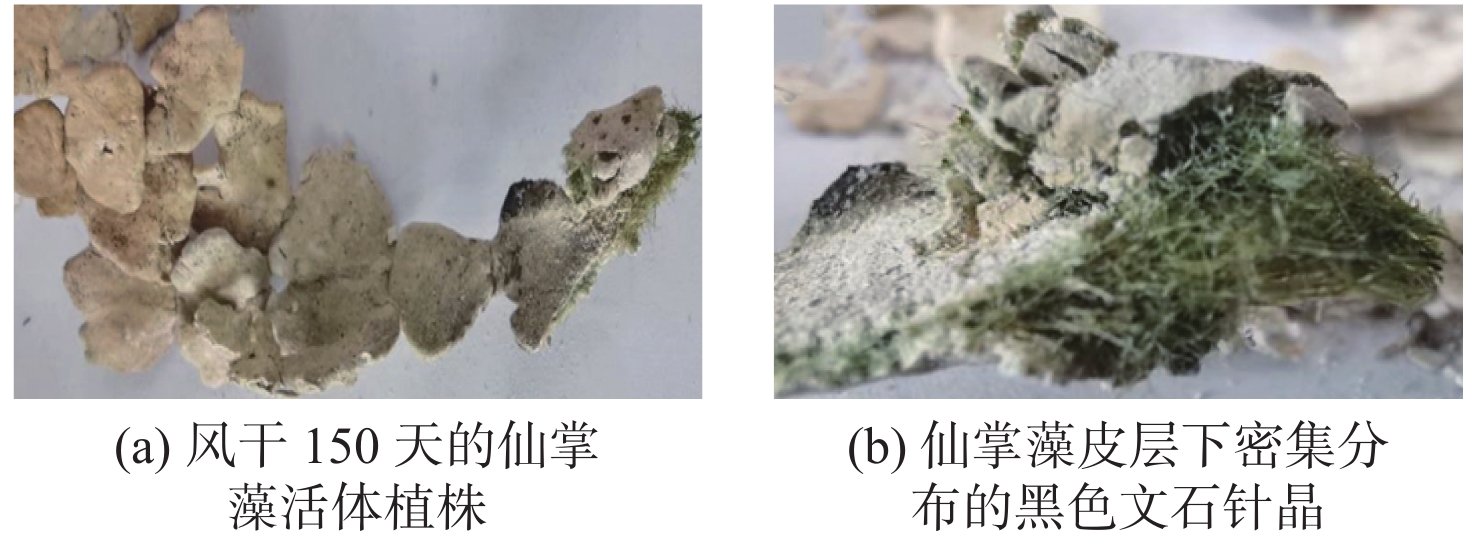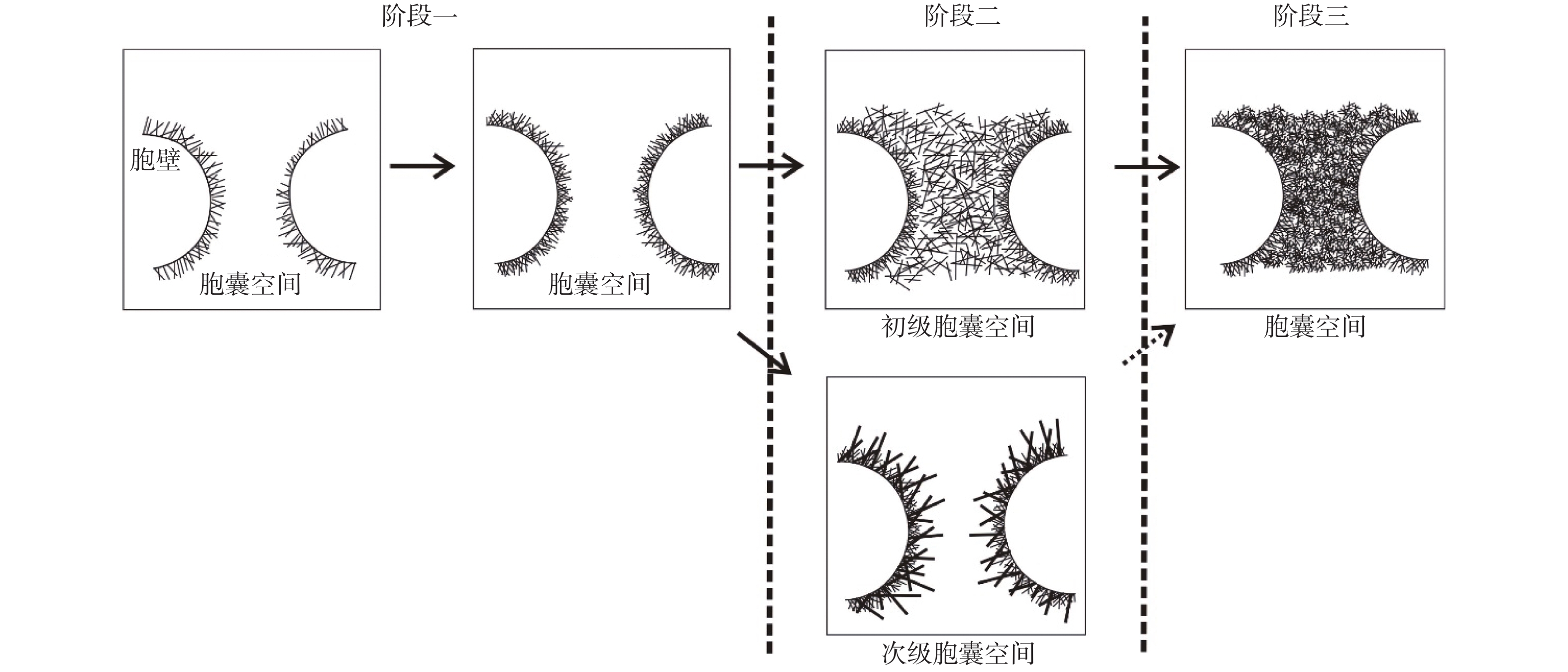RESEARCH PROGRESS OF MARINE REEF-BUILDING HALIMEDA AND HALIMEDA FROM SHIDAO OF XISHA ISLANDS
-
摘要:
仙掌藻(Halimeda)是一种生长在热带浅海环境中的世界性海洋钙化绿藻,为绿藻门(Cholorophyta)松藻科(Codiaceae)的一个属。仙掌藻对生态系统的多样性具有重要贡献,且是一种重要的沉积物生产者,属四大造礁藻类之一。仙掌藻属藻类植物脱落的钙质节片部分,是许多热带海洋环境碳酸盐沉积物的重要组成部分。回顾了仙掌藻的研究历史,总结了其研究成果,包括仙掌藻的现代沉积特征、其对热带环境中沉积物的贡献、钙化模式、海洋酸化对其的影响等。通过对西沙群岛宣德环礁石岛浅水礁盘活体仙掌藻分布特征调查,针对所采集不同种属仙掌藻样品开展镜下分析,尝试估算它们的碳酸盐生产力。最后指出仙掌藻在目前研究中现存的问题,并提出今后研究的建议。
Abstract:Halimeda is a kind of marine calcareous green algae widely growing in the tropical shallow sea of the world. It belongs to the genus of Codiaceae of Chlorophyta according to the biological classification. In addition to its important contribution to the diversity of ecosystem, Halimeda is also an important sediment producer among four major reef-building algae prevailed in various tropical marine environments. In this paper, a thorough review is devoted to the research history of Halimeda, including its depositional characteristics, its contribution to the sedimentation in tropical environment, calcification models, and the influence of ocean acidification onto the sediments. The Halimeda, as the major component of reef deposits at Shidao, the Xuande Atoll of the Xisha Islands is selected as the case of this research. Samples of different species of Halimeda are analyzed under microscope to estimate their carbonate productivity. Finally, the problems existing in the current research of Halimeda are discussed, and suggestions put forward for future researches.
-
Key words:
- Nansha Islands /
- Halimeda /
- carbonate sediments /
- SEM /
- productive forces
-

-
图 5 仙掌藻钙化形成文石针晶的不同阶段特征[45]
Figure 5.
图 6 与钙化作用相关的仙掌藻生理过程模型[46]
Figure 6.
-
[1] FREILE D,MILLIMAN J D,HILLIS L. Leeward bank margin Halimeda meadows and draperies and their sedimentary importance on the western Great Bahama Bank slope[J]. Coral Reefs,1995,14(1):27-33. doi: 10.1007/BF00304068
[2] REES S A,OPDYKE B N,WILSON P A,et al. Significance of Halimeda bioherms to the global carbonate budget based on a geological sediment budget for the Northern Great Barrier Reef,Australia[J]. Coral Reefs,2007,26(1):177-188. doi: 10.1007/s00338-006-0166-x
[3] GROUP B W. World Register of Marine Species[J]. 2013.
[4] 沙庆安. 仙掌藻的文石质骨骼及其变化[J]. 海洋科学,1982(2):20-21.
[5] VROOM P S,SMITH C M,COYER J A,et al. Field biology of Halimeda tuna (Bryopsidales,Chlorophyta) across a depth gradient:comparative growth,survivorship,recruitment,and reproduction[J]. Hydrobiologia,2003,501:149-166. doi: 10.1023/A:1026287816324
[6] HILLISCOLINVAUX L. Ecology and taxonomy of Halimeda:primary producer of coral reefs[J]. Advances in Marine Biology,1980,17:1-327.
[7] WEFER G. Carbonate production by algae Halimeda,Penicillus and Padina[J]. Nature,1980,285:323-324. doi: 10.1038/285323a0
[8] MULTER H G. Growth rate,ultrastructure and sediment contribution of Halimeda incrassata and Halimeda monile,Nonsuch and Falmouth Bays,Antigua,W. I.[J]. Coral Reefs,1988,6(3):179-186.
[9] TUSSENBROEK B I V,DIJK J K V. Spatial and temporal variability in biomass and production of psammophytic Halimeda incrassata (Bryopsidales,Chlorophyta) in a Caribbean reef lagoon[J]. Journal of Phycology,2010,43(1):69-77.
[10] MILLIMAN J D. Recent sedimentary carbonates, part 1. Marine[M]. Heidelberg: Springer, 1974: 1-365.
[11] DREW E A. Halimeda biomass,growth rates and sediment generation on reefs in the central Great Barrier Reef Province[J]. Coral Reefs,1983,2(2):101-110. doi: 10.1007/BF02395280
[12] JOHNS H D,MOORE C H. Reef to basin sediment transport using Halimeda as a sediment tracer,Grand Cayman Island,West Indies[J]. Coral Reefs,1988,6(3/4):187-193.
[13] MARSHALL J F. Halimeda bioherms of the northern Great Barrier Reef[J]. Coral Reefs,1988:6.
[14] MILLIMAN J D,DROXLER A W. Neritic and pelagic carbonate sedimentation in the marine environment:ignorance is not bliss[J]. Geologische Rundschau,1996,85(3):496-504. doi: 10.1007/BF02369004
[15] WIMAN S K. ,MCKENDREE W G. Distribution of Halimeda plants and sediments on and around a patch reef near Old Rhodes Key,Florida[J]. Journal of Sedimentary Petrology,1975,45(2):415-421.
[16] PAYRI C E. Halimeda contribution to organic and inorganic production in a Tahitian reef system[J]. Coral Reefs,1988,6(3):251-262.
[17] JINENDRADASA S,EKARATNE S. Composition and monthly variation of fauna inhabiting reef-associated Halimeda[J]. Proc 9th Int Coral Reef Symp,2002,2:1059-1063.
[18] MULTER H G, CLAVIJO I. Halimeda investigations: progress and problems[R], NOAA/RSMAS, 2004.
[19] ROBLES F R. Carbonate Sands of Isla Perez,Alacran Reef Complex,Yucatán[J]. The Journal of Geology,1964,72(3):255-292. doi: 10.1086/626986
[20] NEUMANN L. Lime mud deposition and calcareous algae in the bight of Abaco,Bahamas:a budget[J]. Journal of Sedimentary Research,1975,45(4):763-786.
[21] ROBERTS H H,PHIPPS C V,EFFENDI L. Halimeda bioherms of the eastern Java Sea,Indonesia[J]. Geology,1987,15(4):371-374. doi: 10.1130/0091-7613(1987)15<371:HBOTEJ>2.0.CO;2
[22] DREW E A,ABEL K M. Studies on Halimeda. I. The distribution and species composition of Halimeda meadows throughout the Great Barrier Reef Province[J]. Coral Reefs,1988,6(3):195-205.
[23] HINE A C,HALLOCK P,HARRIS M W,et al. Halimeda bioherms along an open seaway:Miskito Channel,Nicaraguan Rise,SW Caribbean Sea[J]. Coral Reefs,1988,6(3/4):173-178.
[24] ORME G R,SALAMA M S. Form and seismic stratigraphy of Halimeda banks in part of the northern Great Barrier Reef Province[J]. Coral Reefs,1988,6:131-137. doi: 10.1007/BF00302009
[25] PHIPPS C V G,ROBERTS H H. Seismic characteristics and accretion history of Halimeda bioherms on Kalukalukuang Bank,eastern Java Sea (Indonesia)[J]. Coral Reefs,1988,6(3/4):149-159.
[26] RAO V P,VEERAYYA M,NAIR R R,et al. Late Quaternary Halimeda bioherms and aragonitic faecal pellet-dominated sediments on the carbonate platform of the western continental shelf of India[J]. Marine Geology,1994,121(3/4):293-315.
[27] HILLIS L. Coralgal reefs from a calcareous green alga perspective, and a first carbonate budget[C]//Proceedings of the 8th Int. Coral Reef Sym. 1997.
[28] POMAR L, KENDALL C G. Architecture of carbonate platforms: a response to hydrodynamics and evolving ecology. In: Lukasik J, Simo JA (eds) Controls on carbonate platform and reef development.[M]. SEPM Sepcial Publication, 2008, 89: 187-216.
[29] HILLIS L W. The calcareous reef alga Halimeda (Chlorophyta,Byropsidales):a cretaceous genus that diversified in the Cenozoic[J]. Palaeogeography Palaeoclimatology Palaeoecology,2001,166(1/2):89-100.
[30] KLEYPAS J A, FEELY R A, FABRY V J, et al. Impacts of ocean acidification on coral reefs and other marine calcifiers: a guide for future research[M]. NSF, NOAA, USGS, 2006.
[31] ROBBINS L L,KNORR P O,HALLOCK P. Response of Halimeda to ocean acidification:field and laboratory evidence[J]. Biogeosciences Discussions,2009,6:4895.
[32] RIES J B,COHEN A L,MCCORKLE D C. Marine calcifiers exhibit mixed responses to CO2-induced ocean acidification[J]. Geology,2009,37(12):1131-1134. doi: 10.1130/G30210A.1
[33] RIES J B. Skeletal mineralogy in a high-CO2 world[J]. Journal of Experimental Marine Biology and Ecology,2011,403(1/2):54-64.
[34] SINUTOK S,HILL R,DOBLIN M A,et al. Warmer more acidic conditions cause decreased productivity and calcification in subtropical coral reef sediment-dwelling calcifiers[J]. Limnology and Oceanography,2011,56(4):1200-1212. doi: 10.4319/lo.2011.56.4.1200
[35] HILL R,SINUTOK S,DOBLIN M A,et al. Microenvironmental changes support evidence of photosynthesis and calcification inhibition in Halimeda under ocean acidification and warming[J]. Coral Reefs,2012,31(4):1201-1213. doi: 10.1007/s00338-012-0952-6
[36] PRICE N N,HAMILTON S L,TOOTELL J S,et al. Species-specific consequences of ocean acidification for the calcareous tropical green algae Halimeda[J]. Marine Ecology Progress,2011,440:67-78. doi: 10.3354/meps09309
[37] HOFMANN L C,STRAUB S,BISCHOF K. Competition between calcifying and noncalcifying temperate marine macroalgae under elevated CO2 levels[J]. Marine Ecology Progress Series,2012,464(464):89-105.
[38] 余克服,赵焕庭. 南沙群岛珊瑚礁区仙掌藻的现代沉积特征[J]. 沉积学报,1998,16(3):20-24.
[39] 蔡峰,王玉净. 西沙—南海北部晚第三纪生物礁的比较沉积学研究[J]. 沉积学报,1996,14(4):61-69.
[40] 徐智广,李美真,霍传林,等. 高浓度CO2引起的海水酸化对小珊瑚藻光合作用和钙化作用的影响[J]. 生态学报,2012,32(3):699-705.
[41] 韦章良,莫嘉豪,胡群菊,等. 不同光照强度下仙掌藻(Halimeda opuntia)对海洋酸化的生理响应[J]. 海洋通报,2019,38(5):574-584. doi: 10.11840/j.issn.1001-6392.2019.05.012
[42] TEICHBERG M,FRICKE A,BISCHOF K. Increased physiological performance of the calcifying green macroalga Halimeda opuntia in response to experimental nutrient enrichment on a Caribbean coral reef[J]. Aquatic Botany,2013,104:25-33. doi: 10.1016/j.aquabot.2012.09.010
[43] 许红,赵新伟,EBERLI G P,等. 西沙群岛生物碳酸盐的成因和沉积:来自活体仙掌藻的证据[J]. 海洋学报(中文版),2015,34(4):62.
[44] 许红,朱玉瑞,EBERLI G P,等. 西沙中新世化石仙掌藻礁矿物岩石孔渗层特征及成因模式[J]. 海洋学报(中文版),2015,34(4):74.
[45] MACINTYRE D L,REID W D,MCKENZIE D C. Delayed Muscle Soreness[J]. Sports Medicine,1995,20(1):24-40. doi: 10.2165/00007256-199520010-00003
[46] WIZEMANN A,MEYER F W,WESTPHAL H. A new model for the calcification of the green macro-alga Halimeda opuntia (Lamouroux)[J]. Coral Reefs,2014.
[47] BHM E,TSCHOMAKOV M. Frühe Merkmale einer vitalen Reaktion—Untersuchungen an Schnittverletzungen der Rattenhaut[J]. Zeitschrift Für Rechtsmedizin,1973,72(2):111-118.
[48] NAKAHARA H, BEVELANDER G. The formation of calcium carbonate crystals in Halimeda incrassata with special reference to the role of the organic matrix[J]. 1978.
[49] WEISS I M,FRÉDÉRIC M. The role of enzymes in biomineralization processes[J]. Metal Ions in Life Sciences,2008:4.
[50] FALINI G,REGGI M,FERMANI S,et al. Control of aragonite deposition in colonial corals by intra-skeletal macromolecules[J]. Journal of Structural Biology,2013,183(2):226-238. doi: 10.1016/j.jsb.2013.05.001
[51] SIMKISS K. The organic matrix of the oyster shell[J]. Comparative Biochemistry and Physiology,1965,16(4):427-435. doi: 10.1016/0010-406X(65)90307-5
[52] SIKES A. Regulation of Carbonate Calcification by Organic Matrix[J]. American Zoologist,1984,24(4):933-944. doi: 10.1093/icb/24.4.933
[53] SIMKISS K, WILBUR K M. Biomineralization[M]. San Diego, CA, USA: Academic Press, 1989.
[54] MANN S. Biomineralization: principles and concepts in bioinorganic materials chemistry, vol. 5[M]. New York: Oxford University Press, 2001.
[55] BONUCCI E. Main Suggested Calcification Mechanisms: Extracellular Matrix[M]//Biological Calcification. Berlin Heidelberg: Springer 2007.
[56] CUIF J P,DAUPHIN Y,NEHRKE G,et al. Layered growth and crystallization in calcareous biominerals:impact of structural and chemical evidence on two major concepts in invertebrate biomineralization studies[J]. Minerals,2012,2:11-39. doi: 10.3390/min2010011
[57] BOROWITZKA M A,LARKUM A. Calcification in the green alga Halimeda:III. the sources of inorganic carbon for photosynthesis and calcification and a model of the mechanism of calcification[J]. Journal of Experimental Botany,1976,27:879-893.
[58] VERBRUGGEN H,KOOISTRA W H. Morphological characterization of lineages within the calcified tropical seaweed genus Halimeda (Bryopsidales,Chlorophyta)[J]. European Journal of Phycology,2004,39(2):213-228. doi: 10.1080/0967026042000202163
[59] YÑIGUEZ A T,MCMANUS J W,DEANGELIS D L. Allowing macroalgae growth forms to emerge:use of an agent-based model to understand the growth and spread of macroalgae in Florida coral reefs,with emphasis on Halimeda tuna[J]. Ecological Modelling,2008,216(1):60-74. doi: 10.1016/j.ecolmodel.2008.04.016
[60] BACH S D. Standing crop,growth and production of calcareous siphonales (Chlorophyta) in a south Florida lagoon[J]. Bulletin of Marine Science,1979,29(2):191-201.
[61] GARRIGUE C. Biomass and production of two Halimeda species in the Southwest New-Caledonian lagoon[J]. Oceanologica Acta,1991,14(6).
-




 下载:
下载:




